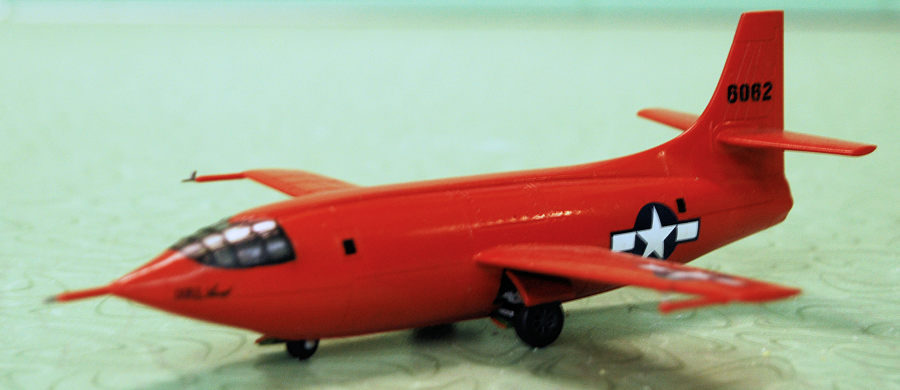
Hobbycraft 1/72 Bell X-1
| KIT #: | HC 1362 |
| PRICE: | $5.00 'used' |
| DECALS: | Two options |
| REVIEWER: | Christopher Campbell |
| NOTES: | Easy to build kit |

| HISTORY |
The X-1 is the stuff of legend. It was firmly immortalized in the public mind after the release of the 1983 film The Right Stuff, based on Tom Wolfe’s historical book about test pilots and the road that led to the Mercury program. In 1997 it was featured on a postage stamp commemorating the fiftieth anniversary of Chuck Yeager’s supersonic flight on Oct. 14, 1947. Sadly, it had been somewhat obscure to the public before this. This was in no small part due to the press blackout in the name of secrecy at the time of this historic flight.
The X-1 began life in 1944 as part of an U.S. Army Air Force project to see if supersonic flight was possible. During the later stages of World War II, the most powerful prop driven aircraft were flirting with speeds that had previously been thought unobtainable. This often came with disastrous results, as the phenomenon of compressibility could result in frozen controls, shattered airframes, and dead pilots. There was even some thought that supersonic flight was an impossibility.
Bell Aircraft had already been working with jets and had produced the somewhat lackluster P-59 Airacomet. This cutting edge jet actually proved slower than the P-51’s and P-47’s already in service. Lockheed’s P-80 Shooting Star was faster and North American and Republic were working on the P-86 and P-84 designs, respectively. However, all of these were designed as warplanes and this first generation of turbojets powering them deemed insufficient to reach or exceed the 700 mph. mark. Bell’s design team was looking into a pure research aircraft to be rocket powered for the maximum amount of thrust possible
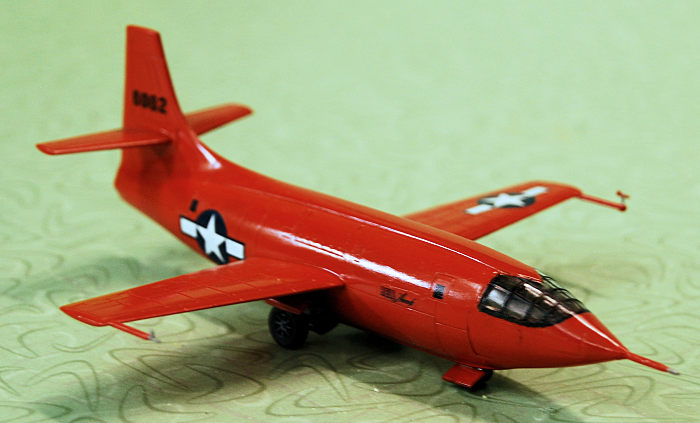 The aircraft
was designed around the silhouette of a .50 caliber bullet, considered to be one
of the cleanest aerodynamic shapes known, with wings and a tail attached to it.
The canopy was made as flush and streamlined as possible.
The aircraft
was designed around the silhouette of a .50 caliber bullet, considered to be one
of the cleanest aerodynamic shapes known, with wings and a tail attached to it.
The canopy was made as flush and streamlined as possible.
Powered by a Reaction Motors, inc., four-chambered XLR-11 rocket engine fueled by liquid oxygen and ethyl alcohol, it produced 6,000 lbs. of thrust. This came with limited duration, though. The aircraft would have to carried aloft by a modified Boeing B-29 Superfortress from which it would be air-dropped, and the pilot would then activate the motor. Flying until fuel was exhausted, it would then come in for a dead stick landing on the dry lake runway at Muroc Army Air Field (Now Edwards Air Force Base).
This was quite unorthodox, to say least. Yet this would soon be the pattern for many aircraft, to include its successors, the Bell X-2, the Douglas D.558-2, and much later, the X-15, HL-10, M2F2, and X-24 series. Starting with the X-1, these aircraft revolutionized aviation and paved the way to space, even to the Space Shuttle itself.
Initially designated XS-1, testing began with several simple glide flights over Pinecastle Army Air Field in Florida in 1946. The program was subsequently moved to Muroc in late 1946 and numerous powered flights ensued. Bell chief test pilot Chalmers “Slick” Goodlin made the first powered flight on Dec. 6, 1946. Goodlin might have gone on to make the first Mach 1 flight. However, he demanded a $150,000 bonus if he did so. This, combined with the slow pace at which Bell had been developing the aircraft displeased the Army Air Force. The project was taken over by the military in conjunction with the N.A.C.A. and less than one year later Captain Charles “Chuck” Yeager took the aircraft past Mach 1 on Oct. 14, 1947. The flight was conducted in total secrecy and passed without notice of the public until the story finally leaked out and was mentioned in Aviation Week two months later. The Collier Trophy was awarded to the program in 1948. However, the career of the Bell X-1 was far from over.
While the initial X-1 airframe continued to be used on research flights, the aircraft was subsequently developed in the X-1A, X-1B, X-1D, and X-1E. These subsequent designs would continue to probe the unknown and set speed and altitude records in the process. Yeager would famously take the X-1A past Mach 2 and suffer a near fatal tumble due to inertial coupling when the tail became aerodynamically ineffective.
Two of the airframes would be lost. The X-1A was subsequently destroyed when a liquid oxygen tank burst shortly before launch. Test pilot Joe Walker escaped without injury. However, the aircraft was jettisoned and destroyed on impact with the ground. A similar fate befell the X-1D on what was to be its first powered flight, the aircraft again being jettisoned, and again, most fortunately with no loss of life.
The final aircraft in the program was the X-1E. It completed its final flight in 1958, being grounded after structural cracks were discovered. This would prove to be one of the longest running test programs, spanning more than a decade. Three aircraft survive located at the National Air and Space Museum, the Museum of the United States Air Force, and Edwards Air Force Base.
| THE KIT |
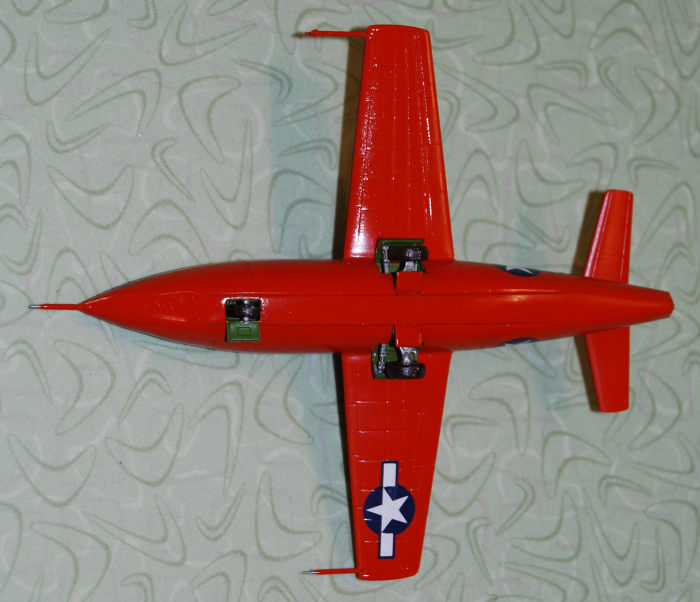 Released in
1991, the Hobbycraft X-1 was the first mainstream, mass produced injection
molded kit of the X-1. The kit was released with options to build an early
version of the aircraft with decals for Yeager’s “Mach Buster” from 1947.
Interestinglly, it also includes the later version of the windscreen with far
less framing used on later flights and decals for an overall white aircraft
flown in this configuration in 1951. (This version was also painted orange at
one point. A photo of it can be seen in the book The X Planes, noted as a
reference.)
Released in
1991, the Hobbycraft X-1 was the first mainstream, mass produced injection
molded kit of the X-1. The kit was released with options to build an early
version of the aircraft with decals for Yeager’s “Mach Buster” from 1947.
Interestinglly, it also includes the later version of the windscreen with far
less framing used on later flights and decals for an overall white aircraft
flown in this configuration in 1951. (This version was also painted orange at
one point. A photo of it can be seen in the book The X Planes, noted as a
reference.)
The parts breakdown looks very much like a scaled down version of the 1/32 Revell kit that I have reviewed previously. The engine is deleted and only a cap with the exhaust ports is offered. The cockpit seems very similar, though slightly simplified. Otherwise, aside from the addition of two windscreens, this kit is very similar to its larger scale cousin. It looks very much as though the Revell kit was used as a template, then scaled down and simplified for accordingly.
I noted that this was the first mainstream X-1 in 1/72. That is essentially correct. However, according to Scalemates, in 1989 a Japanese company called Hobby Spot U released a 1/72 kit the molds of which later became, or were the basis for the Tamiya kit released a year after the Hobbycraft kit. Having never heard of Hobby Spot U, nor seen the kit, it was clearly not something that could be called mainstream. As for it being the progenitor of the Tamiya kit, I cannot say having not seen it. However, I generally find Scalemates accurate in such details.
One notable difference between this model and the Revell kit, if it was, in fact based on it, is the panel detail. The Revell kit features nicely done raised detail throughout most of the kit. The Hobbycraft kit has recessed panel lines. These are bit heavy handed, though, looking something like a Matchbox model. That is something of a pity, as they are thoroughly done over the whole model. However, in this scale, they are a bit too much. This could be addressed with some Mr. Surfacer spray and moderate sanding with fine paper, quite possibly with nice results.
| CONSTRUCTION |
I came upon this kit in a somewhat unexpected manner. One day in 1998, I had spent the afternoon fishing near Wilson Dam in Florence, Alabama. Calling it a day, I decided to drive into town and get something to eat before heading back to Huntsville, where I live. I was driving along the strip on Highway 72 coming into town when I noticed a hobby shop. Naturally, I pulled in.
I am not sure how long this shop had been there, as I had not been to Florence in a few years. Sadly, they were having a going out of business sale. Everything was marked down, so I bought five kits. I do not remember them all, though recall the X-1, the 1/48 Hobbycraft CF-100 Mk.4 Canuck that I have previously reviewed here, and a 1/72 Hobbycraft CF-100 Mk.4 that I still have in the stash, slated for conversion to an early Mk.III. I spent a total of $30 and walked out with five kits. That was good even twenty-seven years ago.
The kit lingered in the stash until about 2018 when I decided to build it. Having already built the most famous version in 1/32 as well as a later N.A.C.A. version, I decided that I wanted to build a very early version here with the U.S.A.A.F. insignia when it was still the XS-1.
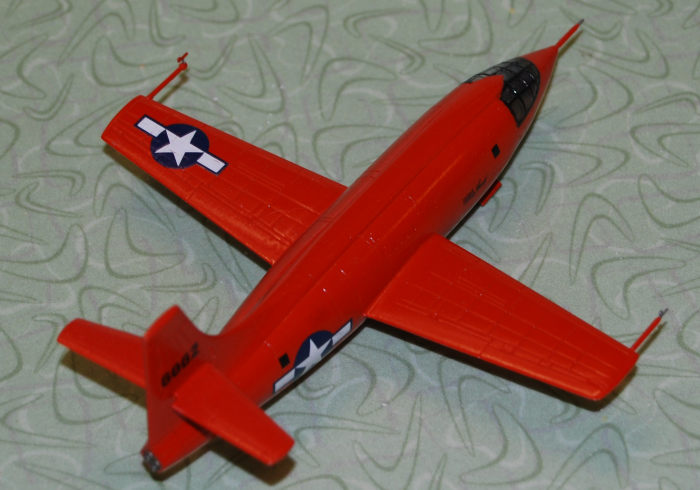 I started with
the cockpit and gave the interior fuselage and cockpit tub a coat of Model
Master Interior Green. The instrument panel and cockpit wall panel were both
painted in Flat Black and the instruments dry-brushed with Testors Silver and
Flat white. Some details were picked out with red and yellow.
I started with
the cockpit and gave the interior fuselage and cockpit tub a coat of Model
Master Interior Green. The instrument panel and cockpit wall panel were both
painted in Flat Black and the instruments dry-brushed with Testors Silver and
Flat white. Some details were picked out with red and yellow.
The seatbelts were painted in a Model Master Buff. Then the buckles were picked out with Model Master Dark Anodonic Grey and a light wash of Tamiya Smoke & Flat Black in denatured alcohol was given to the seat, floor, and boarding area around the hatch. The headrest was painted in Tamiya Flat Black.
The control yoke is a unique, well molded affair with its dual grip and padded central mount. This was painted in Interior Green, Flack Black, Rubber, and Silver, as seemed appropriate based on photos, then glued in place. Finally, the nose gear well was painted in Model Master Chromate Green, as was the underside of the canopy floor and seat area. The wheel well was glued in place and the cockpit assembly was set aside for the moment.
The kit actually comes with a clear post, so I knew that this beast would tail-sit. To avoid this, I used a bullet sinker designed for fishing with plastic jelly worms in the nose. This was glued in place with CA glue. The cockpit and instrument panel were glued in place with CA glue and the alignment checked with another fuselage test fit. Then the same was done with the rudder pedals. After a final alignment check the fuselage halves were glued together with gap filling CA glue. This gave a very clean bond and required no additional filling. Only some minor sanding was needed to smooth out the seams.
The wings are one-piece, unlike the Revell kit. These were glued up with the same CA glue that filled in gaps. At this point, all seams were sanded with some 400 grit sandpaper followed by buffing with 0000 Steel Wool.
The horizontal stabilizers were then fitted, with some care given to assure correct alignment. These went on without any filling and the model was now nearly ready to paint. Before doing so, the nose boom was fitted, but only to assure that any trimming or sanding necessary was done in advance, so as not to have to repaint the nose if the fit was not good. Once satisfied, I purged any dust and debris away from it and my workbench with a blower on the air compressor hose.
| COLORS & MARKINGS |
All openings into the cockpit, the nose gear well, and the exhaust nozzle were plugged with damp paper towel bits, and I prepared to paint it. The color often cited for the X-1’s that were painted in orange is FS 12197. I have always found that this looked far too bright, as well as the wrong color and shade based on the photos that I had seen. I mixed my own using Testors Orange as the base, then tweaking it with drops of various Testors yellows and reds and a drop of Flat White until I was satisfied with the shade and tone. I did not apply this until I let a drop of it dry and found the color suitable.
This was the same process that I used when mixing paint for my Revell X-1, though I got a very slightly different shade. It was, I decided, close enough, though. The whole aircraft was then sprayed in this, as were the outside of the landing gear covers, hatch cover, and the instrumentation booms.
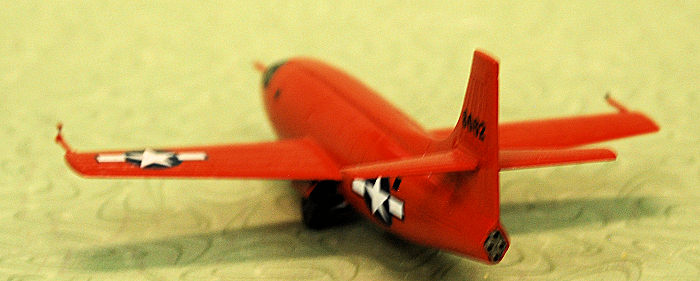 While these
parts dried, the wheel & tire parts were assembled and painted overall Testors
Rubber. The wheels themselves were then painted in Model Master Dark Anodonic
Grey, as were the landing gear components and retraction struts, accented on the
oleos with Model Master Chrome. After the paint was thoroughly dried on the
aircraft, the areas around the main landing gear bays/wheel wells were hand
painted with Model Master Chromate Green. The insides of the gear covers were
painted as well, with the inside of the hatch cover getting a coat of Model
Master Interior Green.
While these
parts dried, the wheel & tire parts were assembled and painted overall Testors
Rubber. The wheels themselves were then painted in Model Master Dark Anodonic
Grey, as were the landing gear components and retraction struts, accented on the
oleos with Model Master Chrome. After the paint was thoroughly dried on the
aircraft, the areas around the main landing gear bays/wheel wells were hand
painted with Model Master Chromate Green. The insides of the gear covers were
painted as well, with the inside of the hatch cover getting a coat of Model
Master Interior Green.
Once everything was dry, the landing gear was assembled and installed per the instructions and the gear covers fitted. This is probably the only tricky part of the assembly. The main gear location is a little more positive than the Revell kit in 1/32. One would almost have to try to make a mess of it. However, the gear covers are a little fiddly due to the fact that even when open, they fit closely and there are retraction struts to be fitted. This is all in a tight space, much to be expected in a kit this small. A little patience and care will assure a correct alignment, though.
The kit was given a shot of Future for a gloss coat, then set aside to dry while I prepared the decals. Kit decals were used with the exception of the national insignia. These were gleaned from a MicroScale sheet in my decal files. All went on without any problems or silvering using Solvaset. Early Hobbycraft decals are on the thick side, and I have heard some modelers cite them as unusable. However, I have used them a number of times with good results so long as stronger setting fluid such a Solvaset is applied, and they are worked with some care. (Those Hobbycraft kits in the black box generally have excellent decals. Ed) Once they had dried, another coat of Future was sprayed on.
| FINAL CONSTRUCTION |
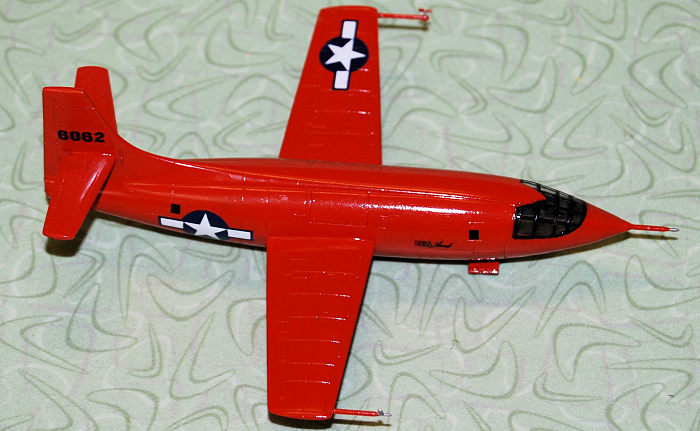 The broad,
heavily framed canopy had been trimmed with an X-acto and test-fitted during
assembly. The framing was now painted in Tamiya Flat Black. Once this was dry it
was given a dunk in Future and set aside to dry some more. During this time the
instrumentation booms had some small details painted with Testors Silver. The
canopy was then glued in place with some CA glue applied to the edges with a
toothpick. I had initially given thought to leaving the hatch off as I had with
my 1/32 scale kits. Ultimately, I glued this in place with CA glue as well.
The broad,
heavily framed canopy had been trimmed with an X-acto and test-fitted during
assembly. The framing was now painted in Tamiya Flat Black. Once this was dry it
was given a dunk in Future and set aside to dry some more. During this time the
instrumentation booms had some small details painted with Testors Silver. The
canopy was then glued in place with some CA glue applied to the edges with a
toothpick. I had initially given thought to leaving the hatch off as I had with
my 1/32 scale kits. Ultimately, I glued this in place with CA glue as well.
The pitot and instrumentation booms were glued in place with CA glue. The exhaust cap was painted with Model Master Dark Anodonic Grey and glued in place with CA glue as well. Now, it was finished and I had a diminutive, very early X-1 to join my ever expanding family of X-planes in my Atomic Lounge.
| CONCLUSIONS |
My only complaint with this kit would be the somewhat overdone panel detail. Otherwise, it is a very nice little kit and easy to assemble. Unfortunately, like most of the Hobbycraft molds, it seems to be lost in Limbo somewhere. It was last released in 1999 and the Tamiya kit a year earlier, leaving us without a readily available early X-1 in 1/72 scale for more than two decades now.
I would recommend this kit to any modeler who would like a 1/72 X-1 kit in their collection. This kit builds up easily and with minimal fuss. I spent only around ten hours or so on it. I will unquestionably build one more at some point, as I want to build one in white with the late windscreen.
The Tamiya kit is superior, though this one is by no means bad. If you happen across one, give it a try. Have fun and Happy Modeling.
| REFERENCES |
The X-Planes: X-1 to X-31, by Jay Miller, 1988, from Aerofax, Inc.
https://www.scalemates.com/kits/hobbycraft-hc1363-bell-x-1--179705
https://en.wikipedia.org/wiki/Bell_X-1#Parallel_development
3 February 2025
Copyright ModelingMadness.com. All rights reserved. No
reproduction in part or in whole without express permission. If you would like your product reviewed fairly and fairly quickly, please
contact
the editor or see other details in the
Note to
Contributors.